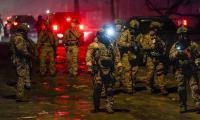Justice(s) on trial
While the stage is abuzz with a medley of ‘dramatis personae’, the spotlight this week has mostly been on the higher judiciary. Specifically, the Supreme Court of Pakistan has moved to the centre. With its capacity for judicial engineering, what are its decisions likely to be?
So much has happened in this context that I am not able to deal with all the developments in any detail. However, there are some reminders of this country’s fateful encounters with judicial waywardness, inspiring serious concerns for the present state of affairs.
Where do I begin, then? If you crave for a bit of cheer in this otherwise gloomy scenario, there was this ceremony on Friday in which Justice Mussarat Hilali took oath as the second female judge of the Supreme Court. She is also the first female judge from Khyber Pakhtunkhwa.
We may take a pause here to celebrate this promotion because Justice Hilali has excellent credentials of being a social activist in her early career as a lawyer. I remember the time when she was associated with the Human Rights Commission of Pakistan. I wish Asma Jahangir were alive to see this vindication of a defender of human rights.
Now, let us turn the page. On Tuesday, Hamid Khan, a leading lawyer of the country who is associated with Imran Khan’s party, said on Hamid Mir’s show on Geo that the disqualification of former prime minister Nawaz Sharif had already been decided before the Supreme Court put its stamp on it. This was a common perception but, coming from Hamid Khan at this time and in such an authoritative manner, the revelation was bound to generate a lot of political comment.
Incidentally, this reference to the Panama Case judgment in July 2017 has coincided with moves that are being made to allow Nawaz Sharif to return – triumphantly – to lead his party’s election campaign and, possibly, become the prime minister for the fourth time. On Thursday, an accountability court verdict said that there was political motive behind an old allotment case against him.
I am tempted to invoke the opening lines of that famous ‘Panamagate’ judgment penned by the then Justice Asif Saeed Khosa: “The popular 1969 novel ‘The Godfather’ by Mario Puzo recounted the violent fate of a Mafia family and epigraph selected by the author was fascinating – Behind every great fortune is a crime. Balzac.” With this literary flourish was conveyed a message that has now become a bit fictional.
Expectedly, the PML-N leaders were quick to commemorate Hamid Khan’s remarks. They were quick to recall the supposedly sympathetic attitude of the Supreme Court of Pakistan towards Imran Khan. There was a lot of mention of former chief justice Saqib Nisar. The present chief justice is also seen to have provided hints that he has a soft corner for the PTI leader – or that is what Imran Khan’s adversaries claim.
Very briefly, it was alleged on social media that in a meeting with some YouTubers, the chief justice had expressed his tilt towards the PTI leader. Justice Umar Ata Bandial was posed questions about this at the oath-taking ceremony on Friday but he did not accept or reject reports about that meeting.
However, there is no doubt about the conflict that has raged between the judges of the present Supreme Court. Very briefly, again, let me refer to the notes of two judges of the Supreme Court who were members of the initial nine-member bench formed on June 21 to hear appeals against military trials of civilians.
These notes written on June 22 were released late in the evening on Tuesday. Justice Masood said that he was not consulted before inclusion in the bench. He endorsed Justice Qazi Faez Isa’s view about first settling the dispute over the formation of benches. Justice Shah said he had decided to sit on the new seven-member bench with certain reservations.
This was the week when, on Wednesday, the anniversary of Gen Ziaul Haq’s imposition of martial law to remove the then prime minister Zulfikar Ali Bhutto from power was observed. That is when a very long night of military rule began that changed the entire sense of direction of this country.
Naturally, when you think of July 5, 1977, you also think of a charismatic leader who had politically awakened the masses of this country. He remains the only person of high status who was executed on the basis of a totally flawed judgment of the Supreme Court of Pakistan. The late Justice Nasim Hasan Shah was on the bench which sent Bhutto to the gallows. It so happened that he was very apologetic about the verdict in a television interview many years after Bhutto’s execution. Former CJ Justice Khosa is his son-in-law.
There was another kind of focus on the Supreme Court this week when the salaries of the chief justice and other judges were increased by 20 per cent and the figures reported became a topic of somewhat incensed discussion in the bazaars, tea shops and drawing rooms. The CJP will now be paid Rs1,229,189 per month while the other judges will get Rs1,161,163.
It was pointed out by some that the top lawyers earn a lot more than these salaries. That is how those who preside over the ruins of our justice system are ‘sentenced’ to virtually live in palaces.
By the way, I have this week read many stories and columns about the Supreme Court of the United States in The New York Times. Their Supreme Court has recently made some very controversial and conservative decisions.
There is also a very long list of books written about the verdicts and the politics of the top court in the US. There is one titled ‘Supreme Inequality’ by Adam Smith. Its sub-title is: “The Supreme Court’s fifty-year battle for a more unjust America”. What would be the title of an authoritative history of our Supreme Court? A battle for injustice?
The writer is a senior journalist. He can be reached at: ghazi_salahuddin@hotmail.com
-
 Apple Foldable IPhone Tipped For 2026 Launch With A20 Pro Chip And C2 Modem
Apple Foldable IPhone Tipped For 2026 Launch With A20 Pro Chip And C2 Modem -
 Meghan Lends Credence To Reports Of Rift With Kim Kardashian On Chicago's Birthday
Meghan Lends Credence To Reports Of Rift With Kim Kardashian On Chicago's Birthday -
 Florida Woman’s Alleged Bid To Bribe Police Ends In Unexpected Discovery
Florida Woman’s Alleged Bid To Bribe Police Ends In Unexpected Discovery -
 James Van Der Beek Strongly Opposes The Idea Of New Year In Winter
James Van Der Beek Strongly Opposes The Idea Of New Year In Winter -
 Elon Musk’s Starlink Rival Eutelsat Partners With MaiaSpace For Satellite Launches
Elon Musk’s Starlink Rival Eutelsat Partners With MaiaSpace For Satellite Launches -
 Fans Feel For Leonardo DiCaprio As He Gets Awkwardly Snubbed: Watch
Fans Feel For Leonardo DiCaprio As He Gets Awkwardly Snubbed: Watch -
 Japan Launches The World’s First Trial To Extract Rare Earth Elements
Japan Launches The World’s First Trial To Extract Rare Earth Elements -
 Prince Harry Breaks Cover In California Amid Tension At Home With Meghan Markle
Prince Harry Breaks Cover In California Amid Tension At Home With Meghan Markle -
 ASAP Rocky Makes Massive Comeback With New Album
ASAP Rocky Makes Massive Comeback With New Album -
 Amanda Seyfried Unveils How Channing Tatum Teased Her On 'Dear John' Set
Amanda Seyfried Unveils How Channing Tatum Teased Her On 'Dear John' Set -
 Blue Moon 2026: Everything You Need To Know
Blue Moon 2026: Everything You Need To Know -
 UN Warns Of 10-year Worst Hunger Crisis In Nigeria After Massive Aid Cuts
UN Warns Of 10-year Worst Hunger Crisis In Nigeria After Massive Aid Cuts -
 Dolly Parton Drops New Version Of Her 1977 Hit 'Light Of A Clear Blue Morning'
Dolly Parton Drops New Version Of Her 1977 Hit 'Light Of A Clear Blue Morning' -
 Redmi Note 15 Pro+5G Set For Global Rollout With Power-packed Features
Redmi Note 15 Pro+5G Set For Global Rollout With Power-packed Features -
 Meghan Markle Sparks Huge Tension With Harry At Home: 'At A Critical Crossroads'
Meghan Markle Sparks Huge Tension With Harry At Home: 'At A Critical Crossroads' -
 Insurrection Act Of 1807: All You Need To Know About Powerful US Emergency Law
Insurrection Act Of 1807: All You Need To Know About Powerful US Emergency Law



